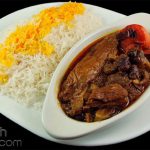Eggplant Stew
It's easy to say most of the Iranian cuisine is made from rice and stew, and we call it Chelo-Khoresht. So far, we told you about Ghormeh Sabzi and Fesenjan Stew, and now I am here to introduce you to the fantastically delicious Eggplant Stew, AKA Khoresht-Bademjan!
Servings: 4 persons
Calories: 312kcal
Ingredients
- For the stew
- 3 Italian eggplants / 4 Japanese/Chinese eggplants peeled and sliced
- 2 tbsp vegetable oil for pan-frying eggplants
- 300 gr Lamb meat copped to 1-inch cubes
- 1 Medium onion roughly diced
- 2 tbsp vegetable oil for sauteing onions
- 2 tbsp Tomato paste
- 1 tsp Salt
- ½ tsp Black pepper
- 1 tsp Turmeric
- 2 cups Water
- ¼ cup Verjuice
- For the rice
- 3 cups of Persian rice/white rice ¾ cup rice per person
- 4 cups water boiling
- 1 ½ tbsp Salt
- 2 tbsp Frying oil for Tahdig optional
Instructions
- Preferably use fresh meat but if you have it frozen, Defrost, and cut them into one-inch cubes
- Peel the eggplants and slice them lengthwise, sprinkle each side with salt and sweat them for five minutes this helps if the eggplants are bitter, dab the excess moisture with a paper towel.
- In a medium-sized pan, heat up one glug of vegetable oil and pan fry your eggplant slices for 2-3 minutes per side or until browned.
- Roughly dice an onion.
- Heat a pot big enough for the amount of your stew and add two tablespoons of vegetable oil, add diced onion and saute for two minutes on medium-high heat.
- Add the cubed meat.
- Season the meat with the seasonings mentioned. Also, add two tablespoons of tomato paste.
- Pour in four cups of water, let it boil, turn the heat down to low, cover the pot with a lid and let it cook for 2-3 hours until the meat is well-done.
- Soak the rice in a bowl of water for thirty minutes.
- Boil four cups of water in another pot.
- Season the boiling water with three tablespoons of salt
- Pour the soaked rice in the pot of boiling water and let it cook on medium-high for 30-40 minutes or until the rice is cooked.
- Strain the rice and wash it with cold water to prevent it from cooking more.
- For Tahdig, slice two to three potatoes thinly (depending on how big or small your pot is, make sure the slices are completely covering the bottom of your pot) or use flatbread.
- Add a glug of vegetable oil to your pot, heat the oil on medium-high and carefully place the pieces of your desired Tahdig (bread/potato)
- Let them crisp up and turn golden-brown before adding the cooked rice.
- Turn the heat down, cover the pot with a lid, and let it steam for 30-40 minutes.
- Meanwhile, over at the pot with your cooking stew, add the previously cooked eggplant slices to your stew and let it cook for an additional thirty minutes.
- Pour in the preferred amount of verjuice and let it boil on medium-high heat for another ten minutes.
- Enjoy!
Notes
Pro tips
Make saffron rice by grinding a pinch of saffron in a medium-sized bowl, mixing it with one or two tablespoons of boiling water, and letting it sit for one to two minutes. Then you add the cooked rice you just made to the bowl, and toss the rice with saffron until it turns golden yellow. You can design your Chelo with spoonfuls of saffron rice.
Making Tahdig is hard for someone who has never done it before, so if you are a beginner stick to flatbread, it turns crispier much sooner, and if you burn it… well, who doesn’t like a little bit of burnt bread.
Make saffron rice by grinding a pinch of saffron in a medium-sized bowl, mixing it with one or two tablespoons of boiling water, and letting it sit for one to two minutes. Then you add the cooked rice you just made to the bowl, and toss the rice with saffron until it turns golden yellow. You can design your Chelo with spoonfuls of saffron rice.
Making Tahdig is hard for someone who has never done it before, so if you are a beginner stick to flatbread, it turns crispier much sooner, and if you burn it… well, who doesn’t like a little bit of burnt bread.
